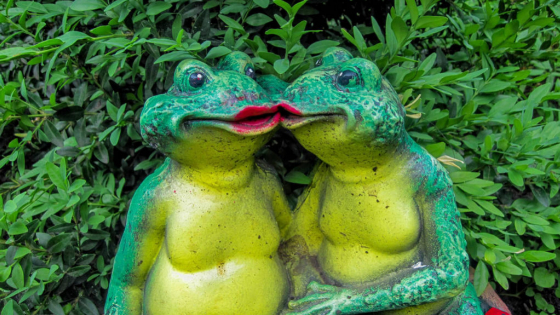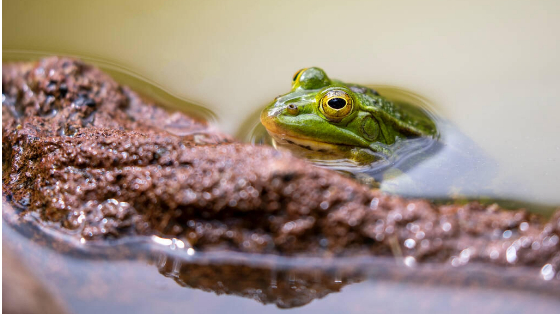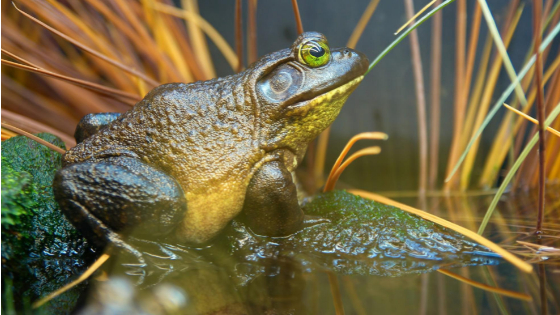
The disappearance of the elusive golden toad, a once vibrant amphibian species, has left scientists perplexed and deeply concerned.
In this article, we will embark on a journey to unravel the factors that led to the enigmatic extinction of the golden toad, exploring its unique characteristics and habitat preferences in the Monteverde Cloud Forest Reserve in Costa Rica.
As we delve into its reproductive patterns and decline, we will shed light on the role of environmental changes in the dwindling population of this remarkable species.
Furthermore, we will examine the conservation efforts made to preserve the golden toad and the lessons learned from its tragic demise.
Two intriguing hypotheses, the climate hypothesis and the fungus infection hypothesis, will be explored to understand the potential causes behind its mysterious extinction.
Stay tuned as we also discuss related topics and ongoing scientific research that unveil the underlying causes of amphibian extinctions, providing valuable insights into the importance of biodiversity conservation.
Key Takeaways
- The golden toad was a species of toad that inhabited the Monteverde Cloud Forest Reserve in northern Costa Rica.
- The population of golden toads declined significantly after its discovery in 1964, with only ten or eleven toads remaining in 1988.
- Factors such as restricted range, global warming, chytridiomycosis (a fungal infection), and airborne pollution have been suggested as causes of its extinction.
- Conservation efforts, including captive breeding programs, were unsuccessful in saving the golden toad, highlighting the importance of preserving habitat and protecting biodiversity.
Description and Habitat
The golden toad, a species in the family Bufonidae, inhabited the Monteverde Cloud Forest Reserve in northern Costa Rica and exhibited distinct characteristics and habitat preferences.
Males of this species were typically orange in color, sometimes mottled on the belly, while females displayed a variety of colors including black, yellow, red, green, and white. Both sexes had smooth skin, with females being larger than males.
The golden toad preferred lower elevations and thrived in cool, moist environments. It was restricted to high-altitude cloud forests with an average elevation ranging from 1,500 to 1,620 meters. The species showed a preference for breeding in small, temporary pools.
Unfortunately, the limited distribution of the golden toad made it vulnerable to environmental changes, ultimately leading to its extinction.
Reproduction and Decline
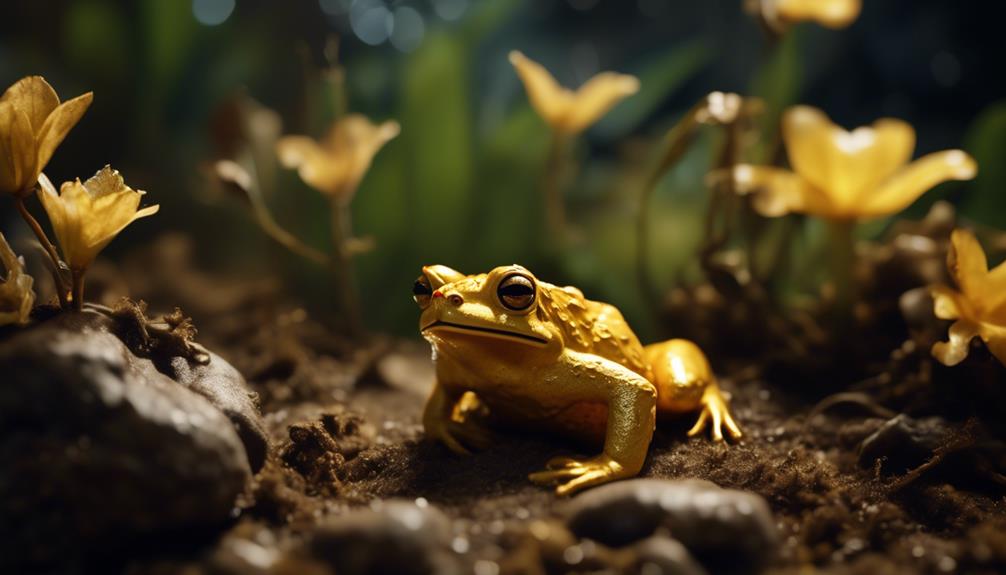
During the mating season, the golden toads emerged in late March through April to engage in reproductive behaviors. They gathered in rainwater pools amongst tree roots to lay their eggs, with males engaging in amplexus with females to facilitate egg-laying. Males outnumbered females, often by ten to one.
Each toad couple produced 200-400 eggs each week during the six-week mating period. However, the golden toad population experienced a significant decline after its discovery in 1964. By 1988, the population dwindled to only ten or eleven individuals.
Researchers suggest that warmer water temperatures and less precipitation during the dry season after 1987 could have caused adverse breeding conditions. Despite subsequent mating seasons with favorable conditions, the species never reappeared, leading to its eventual extinction.
Conservation Efforts and Extinction

After witnessing the significant decline in the golden toad population, conservation efforts were implemented to protect the species and prevent its eventual extinction.
The establishment of a reserve covering 105km around the toad’s habitat was an important step in preserving their environment.
Additionally, the golden toad became a symbol of the global amphibian decline crisis, highlighting the importance of preserving habitat and protecting biodiversity.
Conservation measures, such as captive breeding programs, were also initiated, but unfortunately, these efforts proved to be unsuccessful.
Despite these conservation efforts, the golden toad was declared extinct by the International Union for Conservation of Nature (IUCN) in 2004.
The lessons learned from the golden toad’s extinction continue to inform conservation strategies and emphasize the urgent need for proactive measures to protect endangered species and their habitats.
Climate Hypothesis and Fungus Infection Hypotheses

One possible explanation for the extinction of the golden toad is the interplay between climate change and a fungus infection. The climate-linked-epidemic hypothesis suggests that the decline of the golden toad was a result of a climate change interacting with the pathogen.
On the other hand, the chytrid-thermal-optimum hypothesis proposes that global warming increased cloud cover in warm years, creating optimal conditions for the fungus to grow. However, there is not enough data to prove that climate change had a significant impact on the growth and spreading of the fungus.
It is possible that the testing methods were not robust enough to detect the infection or that the specimens were too damaged to be tested. More data is needed for a conclusive verdict on the role of the fungus in the golden toad’s extinction.
Related Topics and Scientific Research

The investigation into the causes and implications of amphibian extinctions, such as the golden toad, has prompted further research and studies on related topics and scientific research.
One related topic is Holdridge’s toad, which may provide additional insights into amphibian extinctions.
Additionally, the broader phenomenon of the Holocene extinction, which refers to species extinction during the current geological epoch, is another area of interest.
Further research is needed to understand the causes and implications of amphibian extinctions, particularly in relation to climate change and disease.
Studies on the impact of the chytrid fungus on amphibian populations are also being conducted.
Researchers are investigating the reproductive ecology of the golden toad and examining climate variability and its effect on the species.
These efforts aim to understand the ecological and evolutionary implications of the golden toad’s extinction and inform future conservation strategies.
Background

To provide a comprehensive understanding of the golden toad’s extinction, it is important to establish the background information surrounding this significant event in amphibian conservation history.
The golden toad was a species in the Bufonidae family, with males being orange and females displaying a variety of colors. It inhabited the Monteverde Cloud Forest Reserve in northern Costa Rica, preferring lower elevations and cool, moist environments.
The population declined significantly after its discovery in 1964, with only ten or eleven individuals remaining by 1988. Conservation efforts, including captive breeding programs, were unsuccessful, and the golden toad was declared extinct in 2004.
Factors such as restricted range, global warming, chytridiomycosis, and airborne pollution have been suggested as potential causes of its extinction.
Lessons learned from this event continue to inform conservation strategies and highlight the importance of preserving habitat and protecting biodiversity.
Males and Females
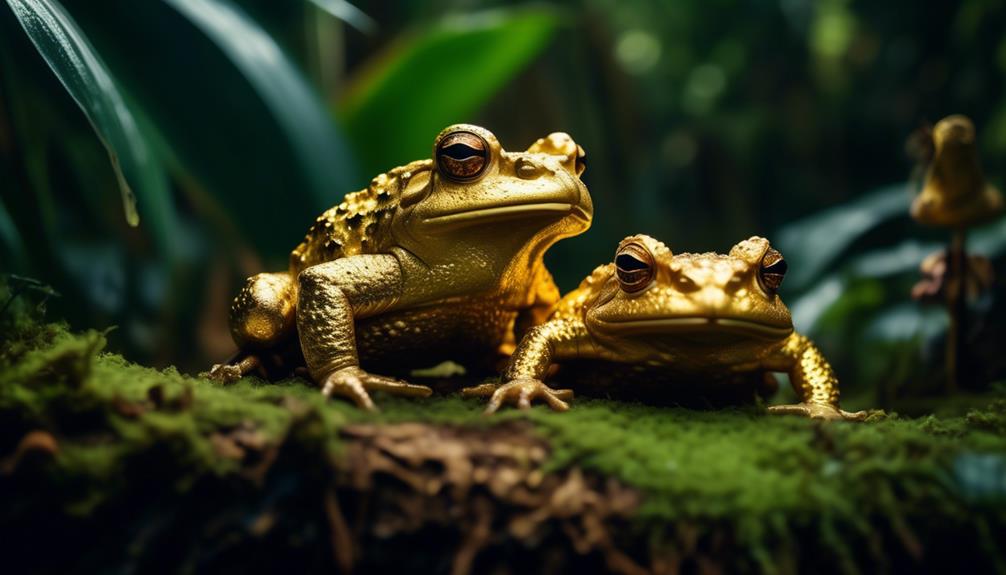
Males and females of the golden toad exhibit distinct coloration and size differences. The males are predominantly orange, which makes them easily recognizable. On the other hand, the females display a wide range of vibrant colors such as black, yellow, red, green, and white.
Apart from coloration, there is also a noticeable difference in size between males and females. Females are typically larger than males.
These differences in color and size likely play a role in courtship and mating behaviors of the golden toad. However, specific details about these behaviors are not mentioned in the available information.
Further research into the reproductive ecology of this species could provide valuable insights into the unique characteristics and behaviors of the golden toad.
Distribution and Habitat Preference
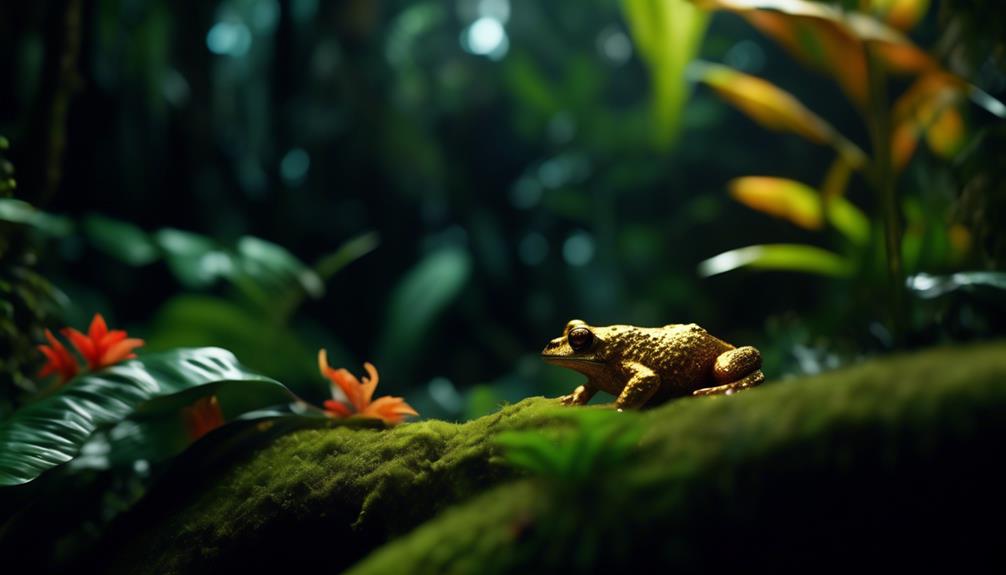
After examining the coloration and size differences between males and females of the golden toad, it is important to understand their distribution and habitat preference.
- Distribution:
- The golden toad was limited to the Monteverde Cloud Forest Reserve in northern Costa Rica.
- Its distribution covered an area of 0.5-8km.
- The species preferred lower elevations, with an average habitat elevation of 1,500 to 1,620 m.
- It was restricted to high-altitude cloud forests.
- Habitat Preference:
- The golden toad thrived in cool, moist environments.
- It preferred breeding in small, temporary pools.
- The limited distribution of the species made it vulnerable to environmental changes.
Understanding the distribution and habitat preference of the golden toad is crucial in comprehending the factors that contributed to its mysterious extinction.
Mating Behavior and Population Decline
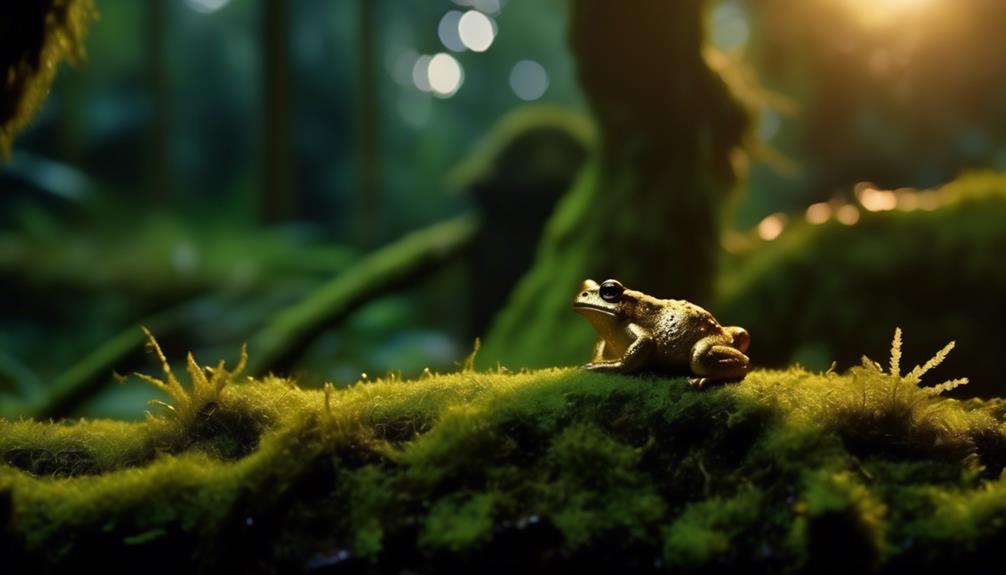
The decline of the golden toad population was closely linked to its mating behavior and subsequent population decline. The golden toads emerged in late March through April to mate, gathering in rainwater pools amongst tree roots to lay their eggs. Males engaged in amplexus with females to facilitate egg-laying, often outnumbering females by ten to one. Each toad couple produced 200-400 eggs each week during the six-week mating period.
However, the golden toad population declined significantly after its discovery in 1964. Warmer water temperatures and less precipitation during the dry season after 1987 could have caused adverse breeding conditions. The scarcity of toads could have been a normal population response to an unpredictable environment.
Despite favorable conditions in subsequent mating seasons, the species did not reappear, suggesting that the toads were not waiting for wetter mating conditions.
Factors Contributing to Extinction
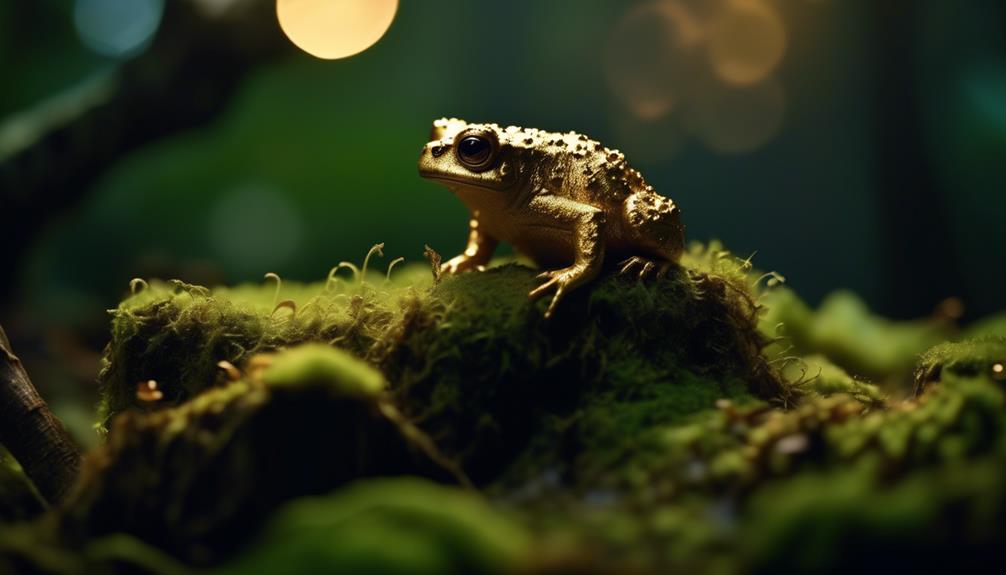
One of the primary factors contributing to the extinction of the golden toad was the combination of restricted range and environmental changes. This limited distribution made the species vulnerable to shifts in its habitat.
Here are two sub-lists that shed light on the factors that played a role in the golden toad’s extinction:
- Restricted Range:
- The golden toad inhabited a small area within the Monteverde Cloud Forest Reserve in northern Costa Rica.
- Its distribution was limited to an area of 0.5-8km in extent, making it susceptible to any changes in its immediate surroundings.
- Environmental Changes:
- The El Niño-Southern Oscillation drought in 1987-1988 is considered a likely cause of the golden toad’s extinction.
- Warmer water temperatures and reduced precipitation during the dry season after 1987 may have created adverse breeding conditions for the toads.
These factors highlight the importance of understanding and mitigating the impacts of restricted range and environmental changes on vulnerable species to prevent future extinctions.
Conservation Measures and Unsuccessful Breeding Programs

Efforts to conserve the golden toad and establish successful breeding programs were unfortunately unsuccessful in preventing its extinction. Despite the recognition of the golden toad as a symbol of Costa Rica’s biodiversity and the establishment of a reserve around its habitat, the population continued to decline.
Conservation measures, such as captive breeding programs, were unable to reverse the species’ decline. The extinction of the golden toad serves as a poignant reminder of the urgent need to preserve habitat and protect biodiversity.
Lessons learned from the unsuccessful conservation efforts for the golden toad can inform future strategies to prevent the extinction of other endangered species. It is crucial to prioritize effective conservation measures and ensure the long-term survival of vulnerable species.
Symbolism and Importance of Biodiversity

Despite the unsuccessful conservation efforts for the golden toad, its significance as a symbol of biodiversity and the importance of preserving natural habitats cannot be underestimated. The golden toad served as a powerful reminder of the incredible diversity of life on Earth and the interconnectedness of ecosystems.
It highlighted the fragility of species with limited distributions and the vulnerability of organisms in the face of environmental changes. The extinction of the golden toad also underscored the urgent need for conservation measures to protect endangered species and their habitats.
Furthermore, the loss of the golden toad emphasized the devastating impact of human activities, such as climate change and habitat destruction, on global biodiversity. The golden toad’s extinction serves as a wake-up call and a call to action to prioritize the preservation of biodiversity for the sake of future generations.
Climate Change and El Niño-Southern Oscillation
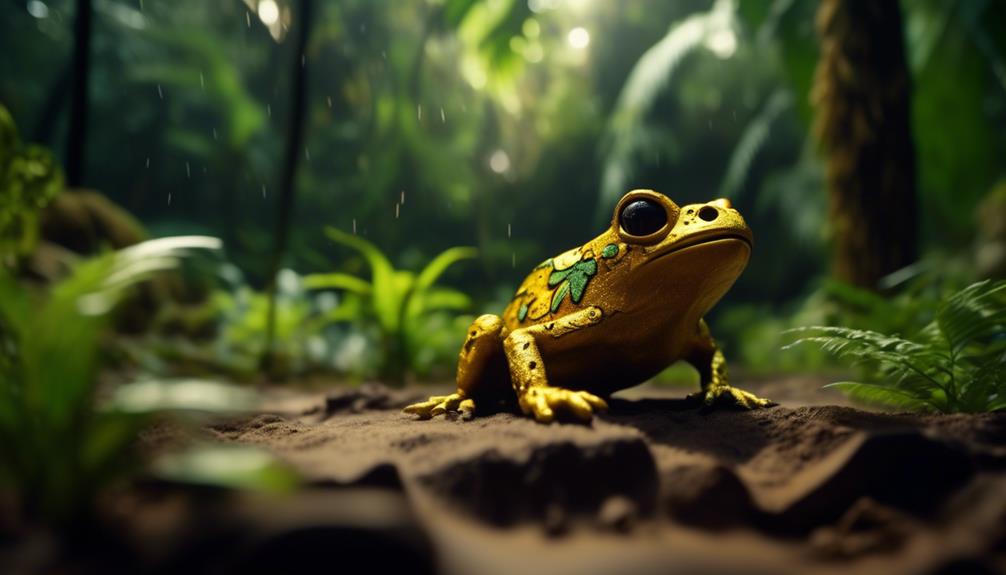
The impact of climate change and the El Niño-Southern Oscillation on the extinction of the golden toad has been a subject of scientific inquiry and debate. Climate variability, influenced by El Niño events, plays a significant role in the survival of species in fragile ecosystems. The El Niño event in 1986-87 caused record low rainfall and high temperatures in Monteverde, Costa Rica, the habitat of the golden toad. This drought-like condition could have disrupted the breeding patterns of the golden toad, leading to a decline in population. Additionally, rising global temperatures have been postulated to have contributed to the occurrence of extreme El Niño events. However, further research is needed to establish a conclusive link between climate change, El Niño-Southern Oscillation, and the extinction of the golden toad.
| Climate Change and ENSO | Extinction of Golden Toad |
|---|---|
| El Niño events | Disrupted breeding patterns |
| Rising global temperatures | Extreme El Niño events |
| Climate variability | Decline in population |
Chytrid Fungus and Its Implication

The investigation into the causes of the golden toad’s extinction turns now to the presence and impact of the chytrid fungus. This fungus, known as Batrachochytrium dendrobatidis, has been implicated in the extinction of many amphibian species worldwide. Its implication in the extinction of the golden toad raises important questions about its role in this particular case.
To draw the audience in and keep them interested, here are two sub-lists that provide further information:
- Impact of the chytrid fungus:
- Chytrid fungus is a pathogen that infects the skin of amphibians, disrupting their ability to breathe and maintain electrolyte balance.
- It has been linked to population declines and extinctions of amphibians in various parts of the world.
- Hypotheses regarding the chytrid fungus’s role in the golden toad’s extinction:
- The spatiotemporal-spread hypothesis suggests that the introduction and spread of the fungus, independent of climate changes, led to population decline.
- The climate-linked-epidemic hypothesis proposes that climate change interacted with the pathogen, contributing to the decline of the golden toad population.
Further research is needed to determine the extent of the chytrid fungus’s impact on the golden toad and its role in its extinction.
Frequently Asked Questions
How Did the Golden Toad Acquire Its Name?
The golden toad acquired its name due to the vibrant golden coloration exhibited by the male individuals. This distinctive feature, along with their elusive nature, contributed to the fascination and naming of this now extinct species.
What Are Some Other Species That Are Related to the Golden Toad?
Some related species to the golden toad include Holdridge’s toad and other amphibians facing extinction. Further research is needed to understand the causes and implications of amphibian declines, including the impact of climate change and disease.
Were There Any Efforts Made to Relocate the Golden Toad to a Different Habitat?
No, there were no efforts made to relocate the golden toad to a different habitat. The extinction of the golden toad was likely caused by factors such as restricted range, global warming, chytridiomycosis, and airborne pollution. Conservation measures, including captive breeding programs, were unsuccessful.
How Did the Golden Toad’s Extinction Impact the Ecosystem of the Monteverde Cloud Forest Reserve?
The extinction of the golden toad had a significant impact on the ecosystem of the Monteverde Cloud Forest Reserve. As a keystone species, its disappearance likely disrupted food webs and altered ecological dynamics, potentially leading to cascading effects on other species and ecosystem processes.
Are There Any Ongoing Conservation Efforts to Protect Other Amphibian Species From Extinction?
Currently, there are ongoing conservation efforts aimed at protecting other amphibian species from extinction. These efforts involve habitat preservation, captive breeding programs, disease monitoring, and research on the impact of climate change and diseases on amphibian populations.
What Factors Contributed to the Extinction of the Golden Toad and What Threats Do Yellow-Bellied Toads Face?
The extinction of the Golden Toad was largely due to habitat loss and climate change. Similarly, endangered yellow-bellied toads face threats such as habitat destruction and pollution. These factors have both contributed to the decline in their population and continue to pose a significant threat to their survival.
Conclusion
In conclusion, the extinction of the golden toad remains a perplexing and concerning event for scientists.
The disappearance of this unique amphibian species highlights the vulnerability of biodiversity and the impact of environmental changes on delicate ecosystems.
The climate and fungus infection hypotheses provide potential explanations for the decline of the golden toad, but further research is needed to fully understand the causes.
The extinction of the golden toad serves as a reminder of the urgent need for conservation measures to protect and preserve endangered species.

